Modern-Day Sant Esteve
Saturday, July 22nd, 2006
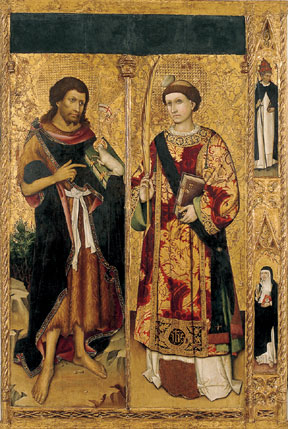
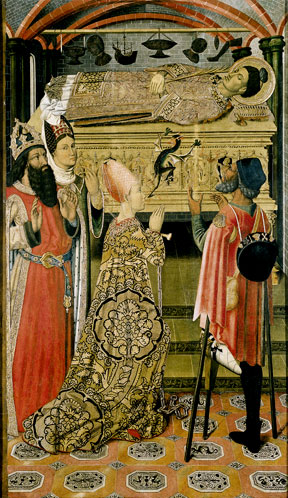
(Joshua took the top photo in Leon, Nicaragua; the gothic paintings of Sant Esteve are in the Museu Nacional d’Art de Catalunya in Barcelona.)



(Joshua took the top photo in Leon, Nicaragua; the gothic paintings of Sant Esteve are in the Museu Nacional d’Art de Catalunya in Barcelona.)
We discovered the Michelada in a small bar in Guatemala City. The bartender added what appeared to be Bloody Mary mixings to a large bulbous stemmed goblet and then topped off with beer and ice instead of tomato juice. We ordered one and watched carefully as he mixed and then we wrote down all the ingredients on a napkin. Then we lost the napkin. Luckily the Michelada is not uncommon, it’s from Mexico, and we have since been able to order them at a Mexican restaurant in Masaya, Nicaragua. Everyone seems to make this drink differently.
Salt the rim of a tall glass. I always forget to do this and add all the other ingredients, then realize the only reasonable way to salt a glass is to turn it upside down, etc. In the end I usually try to mold the salt with my fingers to the rim of an upright glass and it just goes all over the place. Do this step first if have any sense in you whatsoever.
Juice of 1.5 large limes (US style Persian limes) or 2-3 small Mexican limes (key limes).
15 dashes Worcestershire Sauce. This depends upon how generous your bottle of WS dashes out the goods. My “salsa inglesa†generic brand WS is somewhat anemic with the dashes so I go heavy.
3 dashes Tabasco sauce. I read actually that the original Michelada recipe does not call for hot sauce at all, nor does it call for pepper. Shocking I know. (My highly reliable source is The World Wide Internet.) I like that hot sauce though and will boldly go with 5 or 6 dashes if so inclined. Also, I’ve been using Marie Sharp’s (hot) Habanera sauce, because I seem to have a lot of that these days.
1 dash soy sauce. This ingredient is in many online recipes, but the one we had did not use it. I usually put this in since I have some. Incidentally, my internet source did not mention the historical authenticity of this ingredient; I would wager it is not an original ingredient.
3 dashes Maggi Sauce. I had to look this up since I’d never heard of it; it’s a sort of asian seasoning from Switzerland with the following ingredients: water, salt, wheat gluten, wheat, sugar, wheat bran, acetic acid, caramel color, artificial flavor (??), disodium inosinate, disodium guanylate, dextrose monohydrate, and yeast. Obviously I don’t add this and I don’t know if our Guatemala City guy did either. Most online recipes are very specific about this ingredient though. One internet guy said the taste can be approximated by mixing Worcestershire Sauce and soy sauce so there you go.
1 pinch black pepper.
12-oz beer. I noticed that many recipes call for Negro Modelo but that seems a waste when there are so many boring light lager-style beers that are pretty much created for just such a drink.
The method: rub rim of glass with lime and coat with salt. Then add all ingredients except the beer, ice, and finally the beer. Stir. If you are tricky and neurotic like me (mostly neurotic, not so tricky), you will add the ingredients, then the ice, then carefully pour in the beer but not stir. Yet. Most likely your preferred beer glass is just not large enough for all the additives, ice, and beer and so you will be able to pour out maybe three-quarters of your beer only. This leaves you with the dilemma of a non-uniform Michelada. This can be dealt with in two ways. 1) Stir gently but thoroughly, drink down and add the remaining beer, again stirring. This gives your two Michelada tastes: one strong and one less so. 2) After adding the initial amount of beer, gently poke the ice around to mix in some of the ingredients, but leaving the greater concentration at the bottom. When you have drunk down a little, add the remaining beer and mix again, this time more thoroughly. This gives you a more uniform Michelada. I generally go with method number two (the more neurotic) but have been known to go with the first.
A few kilometers from Granada is a private butterfly reserve owned by an American couple who seem to spend the majority of their time in the States working at their respective jobs and living their lives. The reserve is currently populated by a friendly American guy named Gene Rooks who is in the process of writing a book about Central American butterflies and has been doing research at the reserve. The other guy we met is Julio (oh jeez I hope I remembered his name right) a Nicaraguan naturalist/butterfly expert who seems to be the main caretaker of the place. There are a few other caretakers/workers around but that’s pretty much it. The place is incredibly low key and quiet; perhaps sometimes they get students who visit for a time to do research but very infrequently; in reality, the place is relatively new, not in any of the guide books, lacking in a lot of equipment that might make it a more ‘first class’ research destination (like a well, for instance; currently they haul all their own water), and the owners have spent only their own money creating the place (no grants, government or university funding that I am aware of). Anyway, they have a lovely peaceful property, shady with huge trees full of orchids, gardens planted with butterfly-attracting flowers, and a netted-in butterfly garden populated by a freaking ton of butterflies. I pretty much went nuts.
Here are some photos we took inside the netted garden.


Owl butterfly (I unfortunately forgot most the names since they were given to me in Spanish). When we entered the enclosure, Julio seized this butterfly (they are very large and don’t move fast) and to our surprise completely manhandled it while he showed us the parts of the body. Then he chucked it back up into the air where it flitted off to find a new place to sit, totally fine if a little indignant.
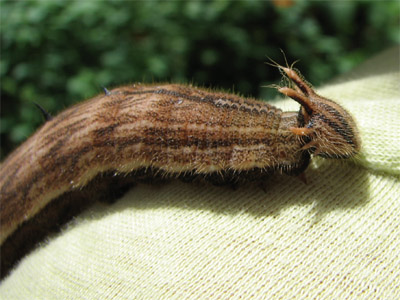
This is the caterpillar for the above butterfly. How cute!! He looks like a little baby dragon slug.

I tried long and hard to get a photo of this guy with the wings open but he would not sit still for a moment. This was the best I could do.
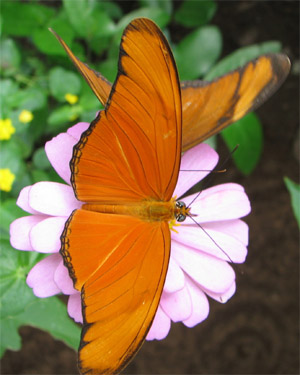
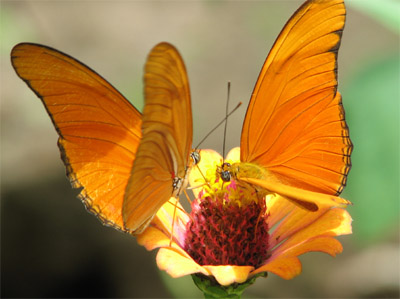
These orange guys were numerous and had cool eyes, whitish with black speckles.
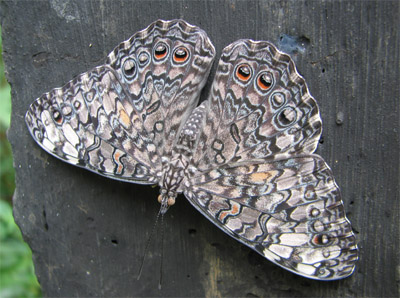
We saw these gray butterflies all over the place in Nicaragua. They were always impossible to photograph even though they tended to settle neatly with their wings open (camouflage on gray tree trunks and the like) because they rarely stopped for more than about five seconds. The males would often sort of ‘dogfight’ in the air while making surprisingly loud clicking noises.
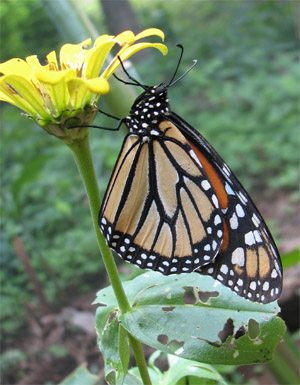
Monarch!
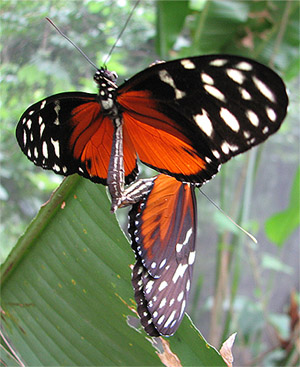
Mating butterflies.
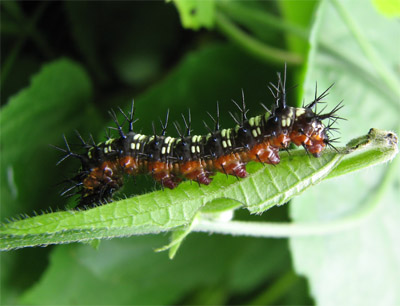
I think this is the caterpillar for the above species.
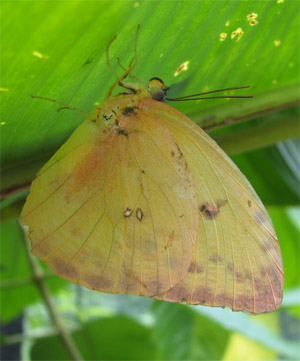
This guy was hiding under a leaf pretending to be a leaf.
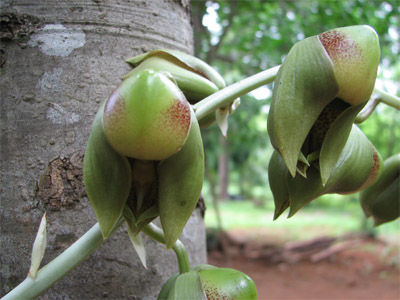
Not a butterfly, obviously, but an orchid. When we arrived, Gene had his camera out to get a photo of this; evidently it completes the bloom cycle in only a couple of days and he wanted to catch it in its prime.
To walk here, pick a day with hopefully some breeze because it is three kilometers down a dirt road from the edge of Granada and hoo boy it can be hot. (Also, bringing some snacks and water wouldn’t be a bad idea.) You can get instructions on how to get here from the tourist information center in town and ask people along the way if you start to worry. Presumably you can convince a cab to drive you if you are not feeling up to the walk; be warned that the road is hell on wheeled vehicles. We got lucky and Julio gave us a ride back to town in the Land Cruiser. Entrance with a tour by either Julio or possibly Gene (if you want English and he’s around) is $7 US. Kind of pricey relative to what things generally cost in Central America but worth it if you are a butterfly geek and in light of the lack of funds to run the place, consider it a donation.

We spent a number of days in Granada under the pretext of taking Spanish classes; however, Joshua lasted only one day and I held out three. Oh well. We did a lot of studying on our own though. We seem to not be able to find very good classes these days. Both of us are at the stage where we need to practice our fluency and just getting information across and most courses seem to only focus on grammar and vocabulary, which is great, but vocabulary certainly is something we can study on our own and learning complex grammar is just not helping me when I can’t even get the simple stuff out of my mouth without leveling a few city blocks.
In addition to not taking Spanish classes, we did a lot of walking around just to spite the dramatic heat. The town is a lovely colonial town built next to an incredibly large lake, from which a steady strong breeze generally blows. Unfortunately, the center of town is not next to the lake (not sure why) and several blocks of concrete and pavement ensure that the heart of the city is well insulated from any sort of refreshing breeze that might make it from the lake.
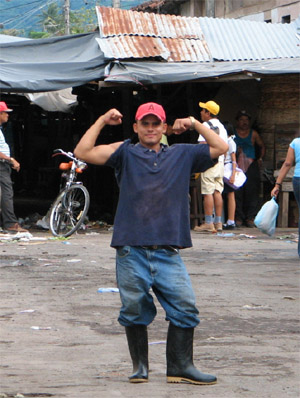
(These guys were hauling ginormous beef carcasses at the Mercado; Joshua was slyly trying to get a photo of the meat but this guy spotted us and decided to take control of the photography session.)
The first day and in fact nearly every day of our stay, we woke up to no electricity. This meant that the fan in the room stopped working and the room would heat up rapidly the moment the sun rose. In addition to the sweltering living quarters, the water ran on an electric pump so it too would stop working. So basically every morning we would come flying out of our room at around 7:15am panting, half dressed, and having to pee to no lights and no water. Someone always managed to get to that first flush in the communal toilet and so we were out on the street generally by 7:18am trying to hunt down a restaurant with the wherewithal to make coffee without electricity and running water in the bathroom. Kathy’s seemed to frequently fit the bill; they even put little candles in the bathrooms so you could see where you were throwing your paper towels, a huge bonus. Kathy’s has really good coffee and American-style fare in addition to the Nicaraguan breakfast (there’s only one: scrambled eggs, pinto gallo—which is rice and beans cooked together, and maybe some fried plantains). Kathy’s is also something of a hangout of the retired guy expat community, being itself owned and run by an expat man and his attractive young Nicaraguan wife.
We met a number of the expat crew during our stay in Granada, usually at Kathy’s. All of them were jovial men in their 60s and upward with young (like early twenties) Nica wives. They would all arrive and cluster around two or three extended tables ranting about the soccer game or the upcoming election or whatever and the wives would all group together and discuss various telenovela dramatics and the latest plot twists. The majority of them seemed to have come recently (within the last five years) from Costa Rica, where they retired initially, did a little speculating, possibly married a Costa Rican woman, but when the cost of living there skyrocketed and crime rates increased, they sold their properties and bought into the Nicaraguan market. A couple of the men we met owned properties that they were fixing up for sale to the foreign market. A strange scene really, but most of the people we met in Granada, tourists not excluded, were really bizarre people with their own trip going. One of the expats described his situation, “Why wouldn’t a guy like me move to Nicaragua? I built a big beautiful house where I have a cook and gardener and good security for pennies. I have a beautiful 22-year old wife. Here I live like a sultan.â€
Granada was the first place we visited in Nicaragua and it was so very different from the places we had visited in Central America, especially El Salvador. First of all, we rarely if ever see any western tourist faces in El Salvador (except other boaters in the estuary) and in Granada, there are many tourists and a large community of expats and foreigners working for NGOs and whatnot. The majority of restaurants in the city center are ‘tourist restaurants’ run by expats, not Nicaraguans, and the locals seem to be scrambling to get in on the tourist market. We got a tense vibe from the place—something similar to what we felt when we visited Antigua and Chichicastananga in Guatamala twelve years ago (granted, Guatemala was still more insane even then than Nicaragua is now). I wonder if Granada might be heading in the same direction as Antigua.
Anyway, enough of why-Granada-is-weird; there is some good food to be had there. We found Nicaraguan food, on the whole, to be less than mind blowing. In fact, after a mere three weeks of travel in the area, I doubt I will be able to face pinto beans again for a long, long time. (Those of you who are aware of my dislike of pinto beans might be amused to discover that I had actually gotten used to and even enjoyed them on occasion in Mexico—and in El Salvador if well seasoned and served with cream and fried plantains.) By the end of this trip, one look at a plate of pinto gallo in the morning was enough to make my stomach turn. Nicaragua has once again killed the pinto bean for me.
Here is a list of our favorite things to eat in Granada.
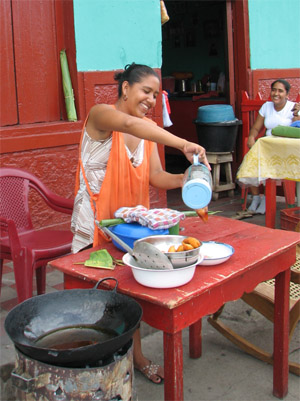
* Buñuelas! Around 5pm every day, the Buñuela Lady mixes a big metal bowl of grated yucca and cheese, gets a small fire going with a wok of oil and drops spoonfuls of the batter to deep fry. She sets up on the sidewalk presumably in front of her house and is there until all the buñuelas are cooked and sold. She charges one cordoba (6 cents) per piece and gives them to you in a small baggie with an amber colored syrup over them. They are incredibly delicious with a golden crispy outside, a tart cheesy inside and the malty sweet syrup. Definitely my favorite street snack in Nicaragua. She can be found in the evenings on Calle el Comercio (also called Atravezada north of cross street Xalteva). Walk south past the central Mercado, past the Texaco station, over the small bridge; she’s another couple of houses on the right (right before you get to a somewhat wide paved street).
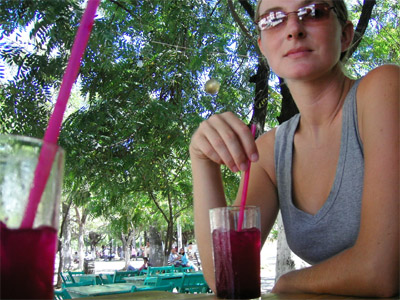
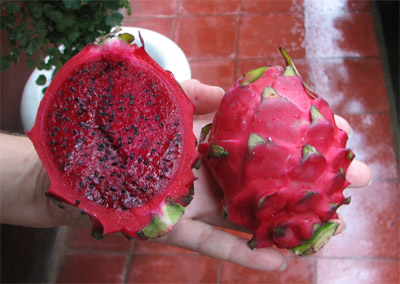
* Pithaya juice. A juice made from the pithaya fruit (looks like a southeast Asian dragon-fruit except intensely magenta inside) mixed with water, lime juice, and sugar. If you are lucky, you get a bunch of the seeds in the bottom which have a pleasing crunching texture. The flavor is great mostly because of the lime juice—the pithaya itself is not terribly intensely flavored—but the color of the stuff makes up for everything. You can get it almost everywhere (market, street juice vendors, Parque Central kiosks).
* Las Colinas. This is a restaurant that serves an excellent guapote (a fish from the lake). It is an enormous place with a well-watered sandy floor and about a thousand tables. The place had been recommended to us by a local girl who said if you want fish, this is the absolute best place in town to get it. We arrived a little before the standard dinner hour and felt a little awkward as we had the place to ourselves. We were also a little surprised that the prices were not as cheap as we were expecting (the small guapote ran around $6.50); however, the “small†guapote is actually rather large and you can order medium and large guapotes. (We probably would have ordered a medium to split had we know there would be so much food.) After we ordered and were drinking our beer, a number of people (all Nicaraguans) showed up and we didn’t feel so alone; almost all of them also ordered the guapote. As promised, the fish was great; the guapote is a fresh-water fish and has a different flavor than the fish we were used to eating. The typical way to prepare it seemed to be de-boned (even de-spined) with the head and tail still intact and then pan-fried with garlic and salt. The fish is crispy on the outside as well as the inside (lots of crispy fried surface area) with tender white flaky meat inside. Las Colinas served it with a tomato, onion, and pepper sauce over the top with French fries, rice, and salad. A ton of food, basically, which is why I might recommend splitting a medium fish if you intend to walk out of there under your own power afterwards. To get there: Follow the basic instructions above to get to the Buñuela Lady. When you get to the wide paved street (right past her house), turn left and walk around three blocks. You will go down a dip in the street and then up a small hill; the restaurant is on the corner, on the right hand side of the street and it is a large, unmistakable place.
* Pizza. For the first time ever traveling, I had a hankering for pizza. A hankering for pizza that spanned several days and we ended up trying three different pizza places in town.
Don Luca on Calle La Calzada: decent but not outstanding pizza; thin crust. My biggest complaint was that the mushrooms were out of a can. What the hell? Why would you bother with mushrooms if the only ones available were from a can? Obviously the few minutes pizza takes to cook were not enough to pierce the moist rubbery consistency or do anything for the flat beige color. The best part was the spicy oil they served along with the pizza. We used a lot of this.
Monna Liza on Calle La Calzada: quite good; again, the evil canned mushrooms but fewer and therefore, less offensive. The crust was great and again, the pizza was served with the spicy oil (not as spicy as Don Luca’s). We ordered negronis for dessert (a campari-gin-sweet vermouth cocktail), which were served over ice, not up (probably due to the heat), but were exciting nonetheless.
Telepizza on Calle El Arsenal: the cheapest of the three and extremely popular with the local Granadians (whereas Monna Liza and Don Luca only had a tourist or expat crowd). We were starving when we went here and the pizza, while less delicate than Monna Liza’s, was hearty and very good. The type of pizza and taste was comparable to any decent pizza place in the states, I would say.
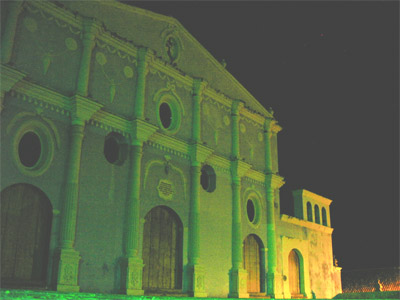
(The blue Iglesia de San Francisco at night.)
* Kathy’s on the corner of Calle El Arsenal and across from the eggshell-blue Iglesia de San Francisco. Extremely pleasant porch seating across from the lovely blue cathedral with numerous fans above that keep the flies at bay. (Did I mention there is an incredible fly problem in Nicaragua? Unreal. I don’t know exactly what it is but El Salvador just does not have them like Nicaragua does. Eating anywhere without a strong fan directly on you requires constant vigilance with a napkin to defend your plate. Beers are often seen on tables with a napkin wrapped over the opening when not being sipped from.) As I mentioned earlier, the coffee is very good here and breakfasts are hearty, American-style. Another similar breakfast place is Ed’s Nica Buffet on Calle Estrada; I think I liked his coffee better than Kathy’s but the setting isn’t as pleasant.
* Vigarón. I enjoyed this dish but Joshua was not so hot on it. It’s worth mentioning because there are ladies with large baskets selling this all over the market; also, there are four kiosks at the corners of the central square and they all serve only vigarón (as well as fresh juices and soda pops). It is cooked yucca chunks with large curls of chicharón (fried pig skin—I’m not a fan but Joshua loves the stuff) topped with a piquant cabbage salad and served on a banana leaf. If you order it from one of the kiosks, you will get a fork to eat it with.
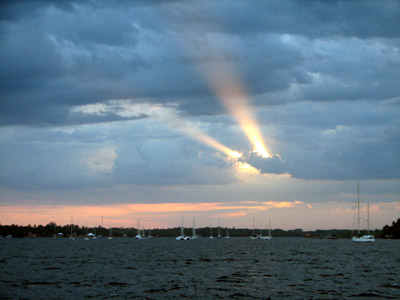
We’ve returned after some inland travel to find our boat, once again, perfectly fine: no outstanding leaks or mold or fires or bats or lightning strikes. Nothing. Evidently the Time Machine has been cooking it’s own meals and entertaining company just fine without us, thank you, and I’m beginning to think we’re just kept around to adjust the rigging.
First thing we do upon return, aside from a cursory examination of the estuary to be sure the boat is still in fact where we left it, is hang out at the hotel bar and check up on the local cruiser gossip to see who’s left, who’s come back, who hopped ship, who got struck by lightning, etc. Also, we need a ride back out to our boat. Rarely is there anything very exciting: “Jan has to go to Guatemala to get her visa renewed!†Glamorous is the cruiser lifestyle.
We were told that last year a group of something like fifty people lived here on their boats through the season; now there are ten. Boris, one of the more impermanent permanent fixtures around here, entered the estuary over a year ago for a quick stay while his wife recovered from a bit of fluish something-something, one thing led to another, and he’s still trying to get the hell out of here. Should be July. Oh wait, it’s July now. August then.
Jan is now a permanent estuary resident. She arrived in a 60-foot sailboat and got some local panga guys to help guide her through the bar. She had a guy hanging off her rigging, white-faced, screaming “Rapido! Rapido! MAS Rapido!†as she ran the bar in her nine-foot draft sixty-foot boat (did I mention it’s sixty feet? That’s roughly twice the length of us). I think she said she bumped the bottom a couple of times during the entry and once inside, she anchored, bought a bit of land on the island, and stayed put.
Then there’s Crazy George. “They call me Crazy George but it’s NOT because I’m crazy.†He lives on a squat little sailboat that boasts a diesel generator capable of keeping up with his all-electric kitchen (including electric stove and oven, apartment-sized refrigerator, and a standard house-sized family of counter appliances), a set of external deck and cockpit floodlights that light up his boat brighter than the sun itself, air conditioner, and a hell of a sound system. He single-hands and likes to stay around 75 miles or so offshore when traveling; at night he says he turns on all his lights and blasts the radio so everyone, in case they are accidentally blinded by the visual splendor that is Crazy George’s Angel, will at least hear him coming and steer clear. “Hell, I don’t play Harry Belafonte when I’m out at sea, I play, uh, you know, what’s his name.†(Eric Clapton, Cocaine.) And then he goes to sleep.